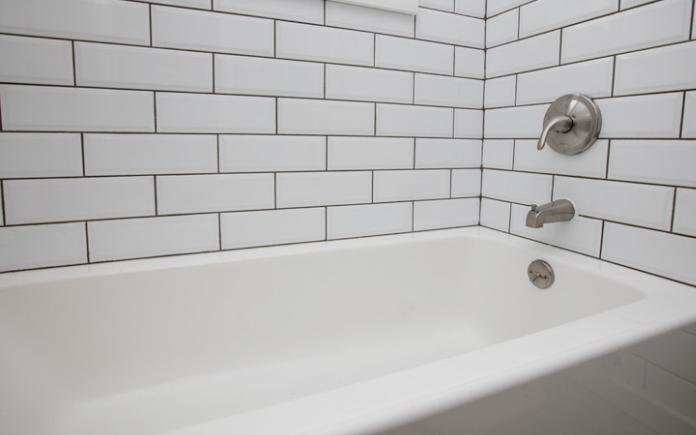
Has your old bathtub seen better days?
If you don’t want to pay to replace it or fit another one over it, try painting it. But be warned, painting a bathtub is not for the faint of heart.
Before you start, you need to get the right kind of paint for your tub. Standard paint or spray paint will flake and peel in a hot and humid bathroom.
You can get that high-gloss, new tub finish with Rust-oleum’s Tile and Tub Refinishing Kit. It’s a two-part epoxy acrylic designed to provide excellent adhesion, durability and color retention in high moisture areas. It’s ideal for ceramic tile and porcelain, fiberglass, acrylic, cast iron and steel tubs and sinks.
Preparation is key, and safety is first. Be sure to wear a respirator to control lead exposure and filter out any airborne particles. You’ll be using lots of products that will emit strong fumes, so turn on your bathroom fan and open nearby windows.
Remove caulk and hardware
Scrape away any caulk around the tub’s edges with a utility knife or putty knife.
Then, remove metal drains and hardware with the necessary tools.
Repair imperfections
Remove loose paint and rust with a wire brush or sandpaper, and repair chips and cracks with a patching compound similar to Liquid Steel.
Clean mildew
Clean the bathtub thoroughly to remove any mildew. Use a solution of 10 percent bleach and 90 percent water and rinse thoroughly.
Scrub dirty or stained surfaces with an abrasive cleaner like Comet. Rinse with fresh water and allow to thoroughly dry. Then, wipe the area down with a clean cloth.
Prepare Bathtub for Painting
Now that you’ve removed imperfections and cleaned mildew, the next step is prepping the tub for the paint. Scrub the entire tub with an abrasive pad and Lime-A-Way. Rinse and repeat if necessary.
Next, sand the entire surface with #400 or #600 grit wet/dry sandpaper. Vacuum or rinse away any residue.
Wipe the surface with a tack cloth immediately before painting to remove dust.
Painting a Bathtub
Use painter’s tape to protect the tile surrounding the tub and any fixtures that you couldn’t remove. Like all projects, it is good to test in a small, hidden area before painting to test adhesion and appearance.
Follow the directions to mix the epoxy paint, and apply it to the tub within six hours of mixing.
If using a brush: Use a fine quality, fine bristle varnish brush. Only brush in one direction for a smooth surface and feather the edges as you paint to avoid a hard line between painted areas.
If using a roller: Use a high-quality, quarter-inch short nap roller made for kitchen or bath use. Before you roll on the paint, be sure to remove any loose fibers from the roller. Wrap the roller with painter’s tape and pull it off to get rid of any excess material.
You can also use a conventional HVLP or airless paint sprayer.
Whether you use a brush, roller or paint sprayer, avoid excessive brushing to ensure an even coat and smooth finish.
Don’t worry if you see any small bubbles on the surface while painting. As the paint dries, the self-leveling properties will eliminate these bubbles.
Apply two coats, waiting at least one hour between coats. If necessary, you can apply a third coat the next day.
Dry Time
Let your painted bathtub dry for three days before exposing it to water. It may feel dry to the touch after an hour, but it will take at least three days for the epoxy acrylic to cure.
After the three-day drying period, recaulk your tub and replace the hardware.
Lastly, and most importantly, enjoy your new bathtub!
Skip to [21:08] for the full segment on the Today’s Homeowner Podcast.
Also on this episode:
- Fixing Front Porch Cracks
- Changing Brick Color
- Painting Dark Wood Paneling
- What to Ask When Contracting a House Painter
Best New Product
 |
Gorilla Ladders 18-foot MPXA Aluminum Multi-Position Ladder is four in one! Learn more>> |
Simple Solutions
Easy Organizer for Garden Tools — Most people store their lawn and garden tools in the garage by simply standing them up and leaning them in the corner. There’s nothing particularly wrong with this except that it’s a little messy and makes it hard to get a tool out. You have to go through a bunch of tools, and sometimes, they fall over.
Here’s a super simple solution to that problem that only requires three concrete blocks. All you need to do is stack up the blocks wherever you want to store your tools. What you end up with is two deep compartments for storing long-handled tools.
The blocks are heavy enough that you don’t have to worry about them falling over, no matter how many tools you put in there.
If you don’t have enough headroom, you can use two blocks so you can lift the tools out. This will give you a neat place where your tools are out of the way and easily accessible, and you don’t have to worry about them falling over.
Watch: How to Easily Organize Your Garden Tools
Garden Coffee Break — Use leftover tea leaves and coffee grounds to acidify the soil of acid-loving plants such as azaleas, rhododendrons, gardenias and even blueberries.
A light sprinkling of about one-quarter of an inch applied once a month will keep the pH of the soil on the slightly acidic side.
Question of the Week
Q: The wood vertical 4×4 posts on my deck are starting to rot at the bottom where they go down into the concrete. Is there a way to repair the posts or must I replace them entirely?
A: Over the years, people have stopped putting the posts down in the concrete because of this.
When you place a post into wet concrete, the moisture stays in the wood even after the concrete is dry. This eventually leads to wood rot.
It might not be too late to cut the rotted part of the post off and put a metal saddle in it. The flat part of the saddle screws down to the concrete and the sides are bolted onto the non-rotted wood. This will keep the wood off the concrete but still utilize the concrete foundation to support the deck.
If the rot is farther up the wood than what a metal saddle can hold, you can try scabbing a fresh piece of post to the existing post. Scabbing is joining two pieces of wood together and shoring them up to increase strength. To do this, you need to support the corners of the deck with temporary posts, and do one post at a time.
Pour a concrete pad or column where the base of the post will be, then put the post on top of a metal anchor.
Skip to [34:49] for the full segment on the Today’s Homeowner Podcast.
Other Products and Links Mentioned
This page contains affiliate links. If you purchase a product from these links, we will earn a small commission at no additional cost to you.
Further Reading
Ask a Question! (Podcast)
Ask a question and we could answer it on the “Today’s Homeowner Podcast!” We also may use it on our nationally syndicated radio broadcast or on todayshomeowner.com.











